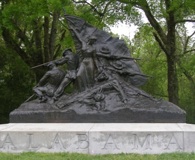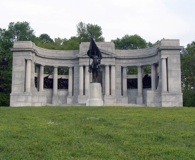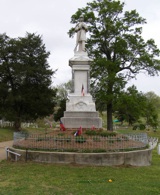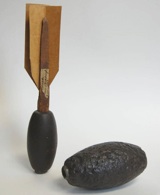The remarkable Alabama State Memorial (above, left), dedicated in 1951, honors the state’s contributions to the Confederate defense of Vicksburg. The woman at the center of the monument, standing in front of a unfurled flag with her right arm raised, represents Alabama. She is surrounded by a group of figures symbolizing the “courage and devotion” of Alabama’s soldiers and women during the war.
Six bronze relief panels depicting the significant contributions of Iowa’s soldiers to the Union success at Vicksburg straddle the elaborate Iowa State Memorial (above, middle) near the end of the park’s 16-mile tour route. In front of the semi-elliptical Greek-Doric structure is a mounted color-bearer, his flag unfurled, awaiting the order to advance.
The Soldiers Rest Confederate Monument (above, right) in the heart of the rolling Cedar Hill Cemetery—located near the intersection of the Mission 66 highway and Sky Farm Avenue, just outside the main grounds of the Vicksburg battlefield—is one of several striking memorials in one of the nation’s oldest and largest cemeteries.
A Confederate flag still flies boldly over the regal Old Court House Museum on Cherry Street in downtown Vicksburg, where Jefferson Davis began his political career in 1844. The cupola atop the courthouse, no longer accessible to the public, was a constant target for Union gunboats in the Mississippi River below.
Among the artifacts in the two-story museum inside the Old Court House are a flag that once belonged to the 21st Mississippi Volunteers and two hand grenades used during the campaign. The Confederate grenade on the left had been thrown into the rifle pits of the 97th Illinois but did not explode and was kept by the regiment’s chaplain. The 3-pound Ketchum grenade on the right was found at Port Hudson, La.









